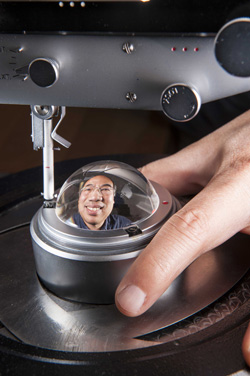ALBUQUERQUE, N.M. — You probably never gave roundness a thought.
But when it’s crucial that something be really round, federal labs and agencies can turn to the Department of Energy’s Primary Standards Laboratory (PSL), operated by Sandia. The PSL is often the last word on measurements, particularly in the world of nuclear weapons.
The PSL develops and maintains precision measurement standards, does measurement assurance training and consulting, provides calibrations and technical support and performs technical surveys and measurement audits. Work there ranges from electrical, physical, dimensional and thermodynamic calibrations for Sandia organizations to reference standards for nuclear weapons plants at Pantex, Y-12 and other nuclear security sites inside and outside DOE, to projects for such agencies as NASA.
Measurement and calibration are critical because they affect the quality of published scientific and technical data, conclusions drawn from that data and certification of product-to-performance requirements. Sandia’s calibrations largely trace to reference standards from the National Institute of Standards and Technology (NIST) for just about anything that can be measured.
“It doesn’t matter what the discipline is, whether it’s voltage or mass or pressure or temperature, you have to quantify it and it has to meet some type of standard” of accuracy, said PSL distinguished technologist Jim Novak.
Take, for example, the standard for roundness, or deviation from a circle. The PSL uses a specialized instrument to measure roundness deviation against a roundness standard, a polished quartz ball nestled in a padded box. That ball, certified to national standards, is round within about 20 nanometers.
“You can’t measure the actual diameter of a circle in here, but we can measure how far off that circle is from being a perfect circle,” said project lead Hy Tran. “We are capable of resolving a tenth of a nanometer from this piece of equipment. … The resolution is exquisite” — to the point that if the quartz ball were Earth size, the instrument could detect hills and valleys about 1¼ inch high.
Most measurements and calibrations are based on comparison.
“You’re always comparing with a standard,” said the PSL’s Bud Burns. “You have a standard, you know what that uncertainty is and you compare an unknown with that standard.”
There’s a gray area with measurements, and instruments are calibrated to keep those uncertainties within acceptable tolerances, Novak said. Over the decades, new instruments and techniques have shrunk the uncertainties.
There are basically two types of measurement standards: those based on an artifact and those that are intrinsic. Measurements often are based on an artifact — something physical such as that polished quartz ball that could vary in the tiniest way from another object based on it. An intrinsic standard, on the other hand, means a measurement can be reproduced anywhere on the planet with the same result because it relies on inherent and reproducible properties of a phenomenon or substance.
The 45,000-square-foot PSL building at Sandia includes 30,000 square feet of specially designed lab space for measurements and calibrations representing more than 100 metrology disciplines — physical and mechanical quantities such as gas flow, acceleration or vacuum standards; radiation, including alpha radiation, laser pulse energy, neutron pulse and solar power; electrical quantities such as DC and AC voltage and current; and microwave electrical quantities. To ensure accurate calibrations, temperature and humidity are rigidly controlled in each PSL lab and the building is shielded from radio frequency waves and electromagnetic radiation and isolated from vibration. Even gravity has been calculated at specific locations within some individual labs because of its importance to precise calibrations.
The PSL has unique capabilities to support the nuclear weapons complex, including pulsed neutrons for neutron generators, microwave devices for radar systems and gas leak measurements for components that must retain seal integrity at different temperatures and pressures, such as from sea level to space.
It also tests how proficiently other DOE laboratories perform their own measurements, based on standards provided by Sandia. If a particular laboratory’s core capability is measuring DC voltage, the PSL sends it a voltage source. The PSL knows what the voltage is, and it’s up to the other lab to measure it. Then the PSL checks to see that the results are what they should be, Novak said.
Sandia has performed calibrations since the 1950s. In 1968, the Atomic Energy Commission, a DOE precursor, designated Sandia to maintain the Primary Standards Laboratory for the weapons complex. That makes the PSL the technical arm of the National Nuclear Security Administration for measurements, Novak said.
For more information on the PSL, visit http://www.sandia.gov/psl/.

